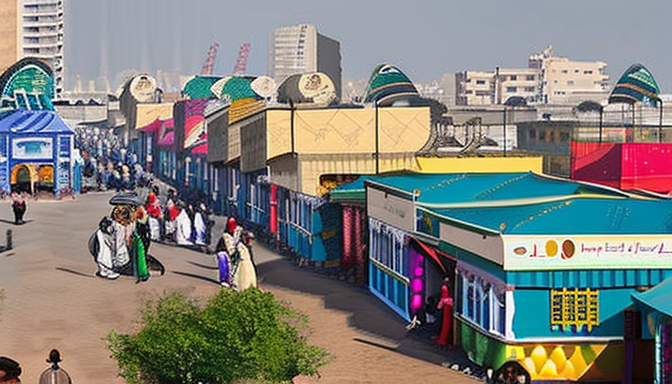Karachi, once a small fishing village, has morphed into a bustling metropolis. Its journey is nothing short of fascinating. Imagine a city that has been shaped by waves of change, each one leaving a mark. From the early days of the Indus Valley Civilization to the bustling streets we see today, Karachi’s history is rich and layered.
In the 19th century, British colonial rule transformed Karachi dramatically. The British saw potential in this coastal city. They built roads, railways, and ports. This infrastructure was not just for trade; it was a lifeline for the city. The population began to swell as people flocked to Karachi for opportunities. Think about it: a city growing almost overnight, filled with diverse cultures and ideas.
Fast forward to the post-independence era. Karachi faced new challenges. The influx of refugees from India brought a mix of cultures. The city had to adapt. Urbanization surged. Skyscrapers began to dot the skyline, while slums emerged in the shadows. The contrast was stark. Yet, through all this, Karachi showed incredible resilience. People banded together, creating communities and supporting one another.
Today, Karachi stands as a testament to its past. It’s a city of contrasts, where tradition meets modernity. It’s a place that continues to evolve, facing challenges head-on. The historic shifts that defined Karachi are not just events; they are the heartbeat of a city that never sleeps.
The Colonial Era’s Impact
The story of Karachi is like a tapestry, woven with threads of different cultures and histories. During the colonial era, the British influence left a significant mark on this bustling city. Imagine a small fishing village transforming into a major port. That’s what happened in the 19th century. The British saw potential, and they acted on it.
With the establishment of the Sindh Railway in 1860, Karachi became more connected. This wasn’t just about travel; it was about trade. Goods flowed in and out, and the city began to thrive. New roads, bridges, and buildings sprang up. The British introduced modern infrastructure, which was a double-edged sword. While it boosted the economy, it also changed the social fabric of the city.
Let’s break down some key changes:
- Urban Development: The British planned the city layout, leading to the creation of areas like Saddar and Clifton.
- Social Dynamics: Different communities began to settle in Karachi, creating a melting pot of cultures.
- Economic Expansion: The port became one of the busiest in the region, drawing merchants and businesses.
However, this rapid growth came with challenges. The influx of people led to overcrowding and tension among communities. Karachi was no longer just a city; it was a vibrant yet complex metropolis. The colonial era set the stage for the dynamic changes that would follow, shaping Karachi into what it is today.

Modern Challenges and Growth
Karachi today is a dynamic city, but it’s not without its hurdles. The rapid pace of urbanization has brought about significant changes. Imagine a bustling marketplace where the streets overflow with people. That’s Karachi! But with such growth comes a host of challenges.
First, let’s talk about population growth. Karachi is one of the fastest-growing cities in the world. It’s like a sponge soaking up people from all corners of the country. This influx has led to overcrowded neighborhoods and strained resources. Basic services like water and electricity often struggle to keep up. Can you picture waiting in long lines for water? It’s a daily reality for many.
Then there’s the economy. Karachi is the economic powerhouse of Pakistan, contributing a large chunk to the national GDP. However, it faces economic challenges like unemployment and inflation. Many young people are eager to work but find limited opportunities. It’s frustrating, right? The city is brimming with potential, yet many feel stuck.
Despite these issues, Karachi shows remarkable resilience. The community spirit is strong. People band together to tackle problems. Initiatives to improve infrastructure are underway. New roads, parks, and schools are popping up. It’s like watching a plant grow through concrete. There’s hope!
In conclusion, Karachi’s journey is a mix of challenges and growth. The city is evolving, shaped by its people and their determination. It’s a tale of struggle, but also one of hope and resilience.
Frequently Asked Questions
- What were the main influences on Karachi’s development during the colonial era?
The British colonial rule significantly shaped Karachi’s urban landscape, introducing modern infrastructure like roads, railways, and ports. This period also saw a mix of cultures, which enriched the city’s social fabric.
- How has Karachi coped with rapid urbanization?
Despite facing challenges like overcrowding and inadequate resources, Karachi has shown remarkable resilience. The city has embraced innovative solutions, such as improved public transport and community-driven initiatives, to tackle these issues head-on.
- What are some contemporary challenges that Karachi faces?
Karachi grapples with several modern challenges, including economic instability, inadequate housing, and environmental concerns. However, the city continues to evolve, with ongoing development projects aimed at addressing these pressing issues.
- How does Karachi’s history influence its current culture?
The rich tapestry of Karachi’s history, marked by various cultural influences, is evident in its vibrant arts scene, diverse cuisine, and communal harmony. This blend creates a unique identity that continues to evolve while honoring its roots.